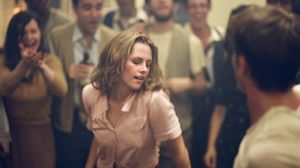_Dear Talia Evtushenko, _Dance Consultant,
I do not know what the spirit of a philosopher could more wish to be than a good dancer. For the dance is his ideal. - Neitzche
Friedrich Nietzsche often mused about how dance can express what words cannot. Especially when it comes to liberating a restless spirit with immediate results. No wonder director Walter Salles relied so heavily on your expertise in adapting one of the 20th century’s most groundbreaking pieces of English prose.
On the Road, of course, is by no means a big screen musical. But it struck me that the film is chaptered by three key dance sequences that segment Jack Kerouac’s story of Beat Generation writers roaming across America in the 1950s. And, in each dance sequence, we are given insight to the evolving relationships of our characters and around them times begin to change.
We begin with a slow dance between Kerouac’s alter ego, Sal Paradise (Sam Riley), and the eager-to-please Marylou (Kristen Stewart). Tepid, respectful, curious, and hopeful, the two share a tender moment in a crowded whites-only bar. Sal is an aspiring writer, still not comfortable in his own skin, and searching for an outlet to explore his intellectual, philosophical, and sexual curiosities. And it all begins with a dance. Yet there isn’t a shred of jealously coming from the carefree gaze of Dean Moriarty (Garret Hedlund), Marylou’s boyfriend—and everyone else’s love affair. We understand immediately that the group’s dynamic will not devolve into melodrama, and their struggles are more about discovering themselves than about discovering their partners. So, with no story engine more powerful than ennui, On the Road we go.
The stage is set for act two: after months of lean living and rotating relationships, our main characters are once again at a bar—this time with explosive live jazz and coloured company. This is where your dance expertise shines. The freewheeling, passion-fueled dance between Marylou and Dean not only captivates the entire bar, but the film audience as well. It’s more than just sweaty foreplay; we feel the characters breaking through a culture still scarred by war, and soon to be scandalized by Elvis Presley’s hips. Powerful thing, that dancing.
And by the film’s climax, Eva, you push them beyond what one might readily define as dance. Experimenting with drugs, sex, and free-form lifestyles has taken its toll on everyone, especially Sal and Dean, who lose control in a Mexican brothel. I’m assuming your direction here was inspired by convulsions and seizures—involuntary movements more akin to electrocution than expressive movement. Absent of all form, their wild gesticulations reflect their new place in society: outsiders who have pushed their personal boundaries so far that they’re now physically and philosophically lost.
I found great inspiration in this crescendo of movement. The script’s pacing is not always as graceful, but road movies seldom are. The genre demands that characters rotate dance partners every few miles, and here we have memorable appearances by Viggo Mortensen, Amy Adams, Kirsten Dunst, Steve Buscemi, and many others. While none of them make the final curtain call, I think everyone deserves to take a modest bow. It was, after all, a very unorthodox beat you were forced to follow.
Fan of your fancy footwork,
Christopher








